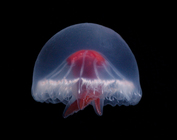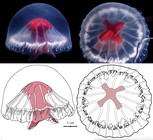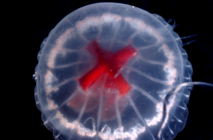WoRMS taxon details
Santjordia pagesi Lindsay, Grossmann, Montenegro & Morandini, 2023
1719587 (urn:lsid:marinespecies.org:taxname:1719587)
accepted
Species
marine, fresh, terrestrial
Lindsay, D. J.; Grossmann, M. M.; Montenegro, J.; Morandini, A. C. (2023). A new subfamily of ulmarid scyphomedusae, the Santjordiinae, with a description of Santjordia pagesi gen. et sp. nov. (Cnidaria: Scyphozoa: Discomedusae: Semaeostomeae: Ulmaridae) from the Sumisu Caldera, Ogasawara Islands, Japan. <em>Zootaxa.</em> 5374(4): 533-551., available online at https://doi.org/10.11646/zootaxa.5374.4.5 [details] 
Holotype NSMT NSMT-Co-1800, geounit Ogasawara Islands
Holotype NSMT NSMT-Co-1800, geounit Ogasawara Islands [details]
Etymology The species name is in honour of Dr. Francesc Pagès, who hosted the first author during his sabbatical in Barcelona and...
Etymology The species name is in honour of Dr. Francesc Pagès, who hosted the first author during his sabbatical in Barcelona and introduced him to the intricacies of cnidarian taxonomy. [details]
WoRMS (2024). Santjordia pagesi Lindsay, Grossmann, Montenegro & Morandini, 2023. Accessed at: https://www.marinespecies.org/aphia.php?p=taxdetails&id=1719587 on 2024-11-14
Date
action
by
![]() The webpage text is licensed under a Creative Commons Attribution 4.0 License
The webpage text is licensed under a Creative Commons Attribution 4.0 License
original description
Lindsay, D. J.; Grossmann, M. M.; Montenegro, J.; Morandini, A. C. (2023). A new subfamily of ulmarid scyphomedusae, the Santjordiinae, with a description of Santjordia pagesi gen. et sp. nov. (Cnidaria: Scyphozoa: Discomedusae: Semaeostomeae: Ulmaridae) from the Sumisu Caldera, Ogasawara Islands, Japan. <em>Zootaxa.</em> 5374(4): 533-551., available online at https://doi.org/10.11646/zootaxa.5374.4.5 [details] 
 Present
Present  Present in aphia/obis/gbif/idigbio
Present in aphia/obis/gbif/idigbio  Inaccurate
Inaccurate  Introduced: alien
Introduced: alien  Containing type locality
Containing type locality
Holotype NSMT NSMT-Co-1800, geounit Ogasawara Islands [details]
From editor or global species database
Etymology The species name is in honour of Dr. Francesc Pagès, who hosted the first author during his sabbatical in Barcelona and introduced him to the intricacies of cnidarian taxonomy. [details]Holotype Umbrella hemispherical; 100 mm diameter, 72 mm height; scattered with nematocysts; mesoglea thick, transparent. Margin cleft into 8 broad lobes (lappets). Eight rhopalia (4 perradial, 4 interradial) located in clefts at margin; 24 additional adradial rhopalia located on the subumbrellar surface but protruding through tear-drop-shaped perforations in the velar lobes (3 per octant) (Figs 2, 3f). Tentacles subumbrellar; up to 60 per quadrant; located in pits in 2 rows along inner [proximal] and outer [distal] surfaces of ring canal; tentacle pits demarcated by rhopaliar canals and other less obvious subumbrellar gelatinous ridges; single tentacle at base of each adradial canal just proximal of where it joins ring canal, not in a pit; tentacle bases light pink when alive, cream in formalin. Tentacle nematocysts composed of small holotrichous a-isorhizas (average length 8.91±0.74 μm, average width 5.09±0.42 μm; range 7.3–11.0 μm×4.2–6.6 μm; n=95) and heterotrichous microbasic birhopaloids (average length 11.63±0.98 μm, average width 8.24±0.24 μm; range 10.0–12.6 μm×7.8–8.5 μm; n=10) (Fig. 5). Subumbrellar musculature not discernible. Subgenital ostia absent. Manubrium height equal to or slightly greater than bell radius; surrounded by thick transparent mesoglea with inner surface red-pigmented. Four V-shaped oral arms; bases fused and following outline of cross-shaped stomach; tips protruding below umbrella rim; with transparent papillae on tips and inner edges, thick transparent mesoglea extends to distalmost ends of oral arms, inner surfaces red-pigmented. Central stomach cross-shaped, red when alive, dark brown in formalin; gastric cirri in 4 pairs of perradial groups, whitish in live specimen; radial canals simple, not anastomosing, similar width throughout length, connected by a ring canal located ~1/3 bell radius away from margin; short rhopaliar canals emanating from ring canal to all sense organs; 4 perradial canals, one each emanating from centre of distal tips of stomach base; 4 interradial canals, one each emanating from centre of stomach base; 8 adradial canals, two each emanating from distal tips of stomach base, one at each corner, not in direct communication with perradial or interradial canals. Gonads not recognized. [details]
Phylogeny The analysis of sequences of the mitochondrial 16S gene using maximum likelihood (ML) and Bayesian methods gave congruent tree topologies (Fig. 6). Robust support was evident for the semaeostome clades Drymonematidae and Cyaneidae, and for another clade including the ulmarid subfamilies Poraliinae and a member of the Ulmarinae, but also including the recently erected family Phacellophoridae. In fact, higher support was evident for Diplulmaris (Ulmarinae) and Phacellophora (Phacellophoridae) being more closely related to each other than for a close relationship between some of the ulmarid genera investigated. Somewhat surprisingly, there was reasonable support for Santjordia pagesi gen. et sp. nov. belonging to a sister group to a clade including the ulmarid subfamilies lacking marginal tentacles—Stygiomedusinae + Tiburoniinae + Deepstariinae. A BLAST search for the COXI sequence returned a maximum percentage identity of 82.62% with a query cover of 95% matched with Aurelia coerulea, with the next closest match being Rhopilema aff. esculentum at 82.21% and 97%, respectively. These low values are indicative of the COXI marker not being suitable for resolving higher phylogenies and further analysis was not attempted. Sequences determined in the present study have been registered on GenBank under accession numbers ON391151-ON391163 for 16S and ON496462 for the single COXI sequence, belonging to Santjordia pagesi gen. et sp. nov. All sequences used in the molecular analysis are listed in Tables 1 and 2. Images of sequenced specimens, where available, are available online on Zenodo (Lindsay 2022a–k). [details]



